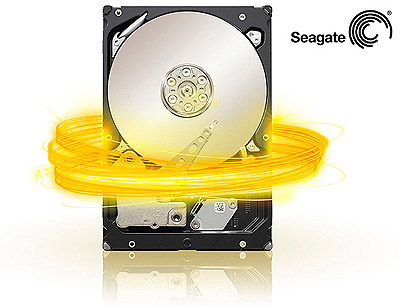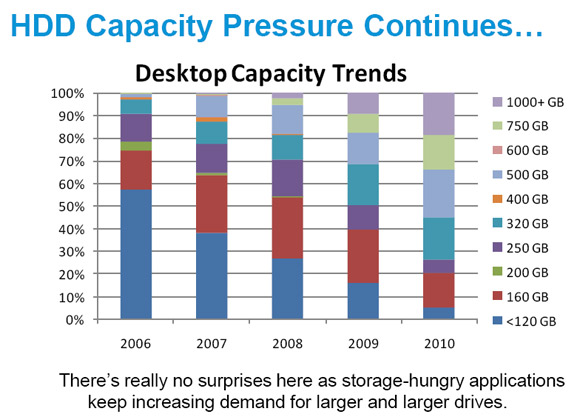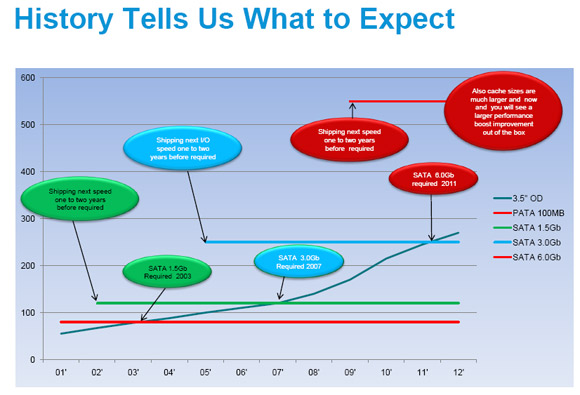Hard drive
capacity is always on the up and up, but the standards which
enable the PC to access those Terabytes of data, such as IDE
and SATA, change much less frequently. Today Seagate is inaugurating the latest
speed bump for SATA storage devices - SATA 6Gb/s - with a new desktop
hard drive called the Barracuda XT.
What's notable about Seagate's
desktop 2TB Barracuda XT hard drive is that it's the
worlds first 3.5" hard drive to support SATA-IO's
Serial ATA 6Gb/s interface
. The Barracuda XT is built around a four platter 7200RPM spindle framework, with ramp
loading for the heads and 64MB cache. I suspect 128MB cache drives are not too
far off in the future, although Seagate declined to comment specifically when PCSTATS
spoke with company reps recently.
Western Digital has of course offered 2TB Caviar Black hard drives with
similar specs for a while now, including 64MB cache, but its drives operate on
the previous generation 3Gb/s SATA II interface.
Architecturally the Barracuda XT is quite similar to the
popular Barracuda 7200.12, so evidently the bandwidth advances are
coming by way of the enlarged cache and shiny new SATA 6Gb/s
controller, rather than changes to its perpendicular magnetic recording technology. The Seagate Barracuda XT
has an areal density of 368 Gigabits per square inch, is capable of
burst speeds of up to 6 Gb/s and supports Native Command Queuing. Expect sustained data rates
of around 138MB/s. The Seagate ST32000641AS 2TB hard drive
will run about $290 and come with a 5 year warranty.
PCSTATS will have a full
set of performance benchmarks on the Seagate Barracuda XT SATA 6G hard
drive very shortly. In this quick preview we're going present a basic
overview on the SATA 6G standard, let you know what critical piece
of hardware is needed to actually take advantage of it.
Top of the list - High SATA 6G Expectations
Hard drives rated to SATA 6Gb/s interface speeds will communicate with a PC
faster, but at the outset the speed bump is going to be muted, and certainly in
real world terms not
twice as fast as a 3Gb/s drives. Put it this way; Serial
ATA I operates at 1.5Gb/s, Serial ATA II operates at 3Gb/s and Serial ATA
6G runs at 6Gb/s. You'd be hard pressed to saturate a SATA II connection with
3Gb/s burst of data for anything more than a fleeting moment, and that's why SATA
6G, while faster
, will initially only have a small impact
on bandwidth intensive situations.
Mechanical hard drives just aren't fast enough
to saturate a 6Gb/s bandwidth connection continuously, but moving forward new
technologies and Solid State Drives (SSD) will likely require the
additional head room.
 Incidently, the Serial ATA International Organization which
controls SATA standards have banned the term "SATA III" from being used because
it gets confused with SATA 3Gb/s too easily. The correct name for the new
standard is SATA 6G or SATA 6Gb/s interface.
Incidently, the Serial ATA International Organization which
controls SATA standards have banned the term "SATA III" from being used because
it gets confused with SATA 3Gb/s too easily. The correct name for the new
standard is SATA 6G or SATA 6Gb/s interface.
The critical hardware? Marvell Semiconductor's 88SE9123
chip
Serial ATA devices enjoy a great degree
of backwards compatibility as the cabling and connectors have remained unchanged from
the initial 1.5Gb/s bandwidth interface to 3Gb/s, and now 6Gb/s. However, to take advantage of SATA
6G your computer will need two critical pieces of
hardware.
The
first is a motherboard or expansion card equipped with the Marvell 88SE9123 SATA 6G controller, and the second is
a hard drive rated for SATA 6G interface speeds.
If one or the other is absent the drive will fall back to SATA 3Gb/s.
It's worth noting that neither the Intel P55 Express nor AMD 785G chipsets natively support SATA 6G standards, and
its not something a firmware or BIOS upgrade can
introduce.
Currently there are two motherboard models that ship
with the Marvell Semiconductor 88SE9123 SATA 6G controller, the Gigabyte GA-P55 Extreme and
ASUS
P7P55D Premium. As of this writing no motherboards
for AMD Phenom II processors or Intel socket 775 CPUs have been announced
which incorporate support SATA 6G, but ASUS is planning to release a SATA
6G PCI Express expansion card so existing PC platforms can be upgraded easily
enough.

Do you need SATA 6G?
While
computers equipped with SATA 6Gb/s hard drives will certainly
be future-proof and meet the growing demands of gaming, digital video
editing and storage-hungry applications in the years to come, the initial boost in "performance" isn't expected to be dramatically greater
than what SATA II delivers currently. If you're building a new PC based on
Intel's Core i5 / P55 Express platform and want SATA 6G, it's certainly
there for the taking. In six months from now I'm sure most performance grade motherboards
will feature the technology and more than one hard drive manufacturer will be supporting
it.

Marvell Semiconductor is the first
to market with a SATA 6Gb/s solution, but you can bet that SIL
is not far behind. For the initial launch of SATA 6Gb/s Marvell has
partnered with both ASUS and Gigabyte offer motherboards to complement SATA 6Gb/s hard
drives.
ASUS was first to market with a SATA 6Gb/s motherboard,
the ASUS P7P55D Premium began
shipping in August. Joe Hsieh of ASUS noted; "An expansion bridge integrated into
the P7P55D Premium helps achieve real SATA 6Gb/s throughput to support
bandwidth-hungry applications. The ASUS solution eliminates transmission
bottlenecks in current technology and ensures users truly enjoy faster data
speeds and double the storage bandwidth. For other P7P55D Series models, ASUS also provides an expansion card to achieve the
same results."
On the other side of the fence, Gigabyte's Intel P55
Express-series GA-P55-Extreme
motherboard is also now shipping. Tony Liao of
Gigabyte mentions; "Gigabyte worked closely with our partners Seagate and Marvell in making the highly anticipated SATA 6Gb/s technology
a reality."
Seagate will be demonstrating Serial ATA 6Gb/s
Technology at the Intel Developer Forum this month, and PCSTATS will have a full hands-on review shortly thereafter so please
stay tuned!
Oh more more interesting note from PCSTATS' briefing with
Seagate on the SATA 6G technology and its Barracuda XT hard drives. The company
is updating its Seagate SeaTools hard drive configuration software to make
it easier for PC enthusiasts to "short stroke" drives. Short Stroking is a
technique most often employed by gamers to restrict data to the outer areas of
the drives platters, where data rates are highest. Seagate SeaTools will very
shortly incorporate "ShortStroking" options in the standard feature set.
Find out about this and many other reviews by joining the Weekly PCstats.com Newsletter today!
Catch all of PCSTATS latest reviews right here.
Related Articles
Here are a few other articles that you
might enjoy as well...
- Western Digital Caviar Black WD1001FALS 1.0TB SATA Hard Drive
Review
- IcyDock MB673SPF-B 3-Bay Tooless Hard Drive Bay Module
-
IcyDock MB674SPF-B 4-Bay Tooless Hard Drive Bay Module
- Icydock MB664US eSATA/USB External Hard Drive Enclosure
Review
- IcyDock MB454SPF-B SATA 4-Bay Hot-Swap 3.5-inch Drive Bay
Review
- IcyDock MB453SPF-B SATA Multi-Bay Backplane Module
Review

